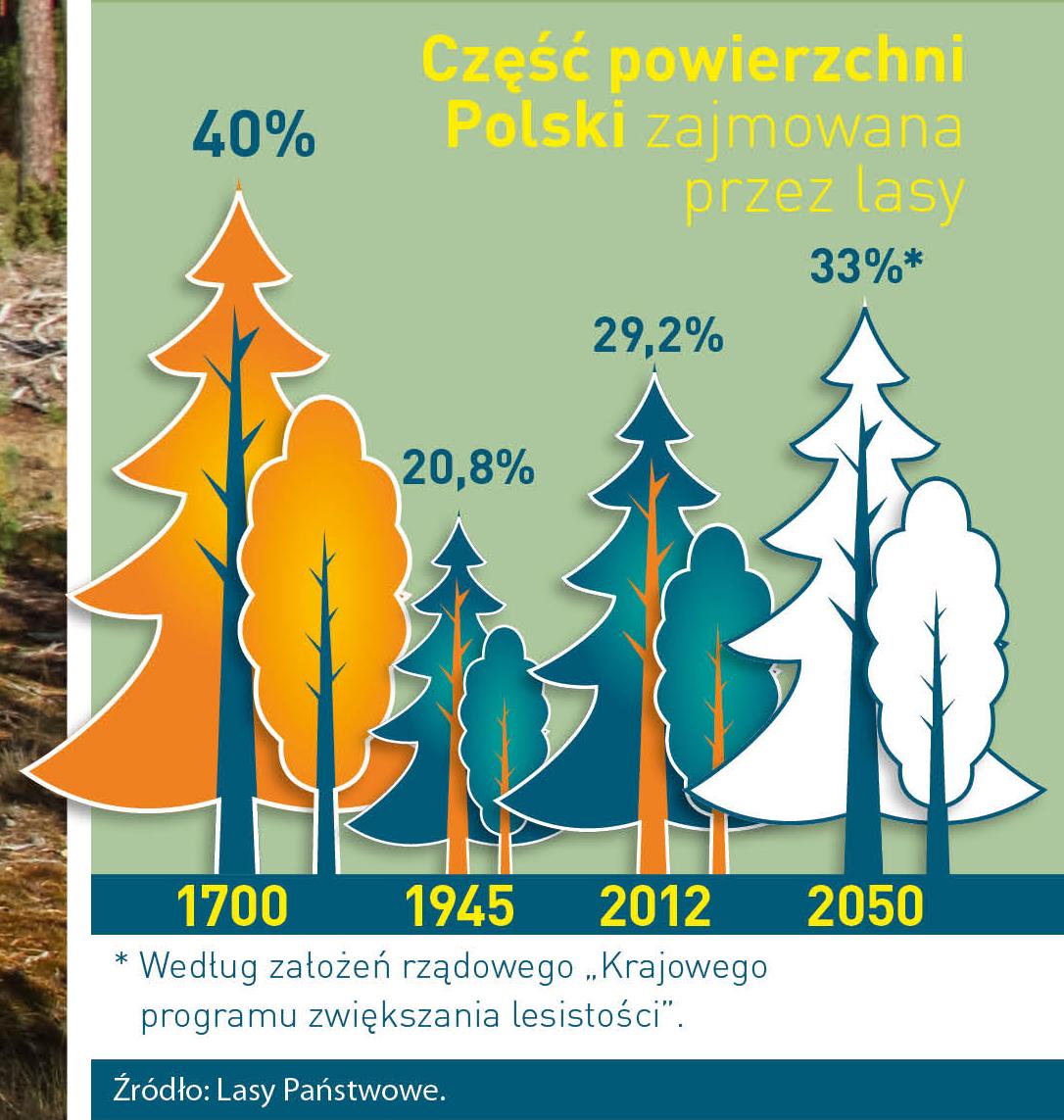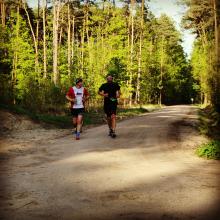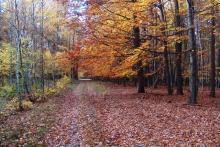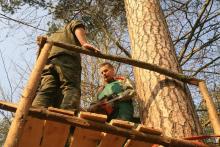 Asset Publisher
Asset Publisher
Polish forests
Poland is in the European lead, while concerning the area of all forests. They cover about 29,2 % of the country territory, and grow within the area of 9,1 million hectares. The overwhelming majority of the forests is state owned, of which almost 7,6 million hectares are managed by the State Forests National Forest Holding..
The number of Polish forest is still growing. The forestation rate of the country has increased from 21 % in 1945 to 29,2 % at the moment. Between 1995 and 2008, the forest area increased by 310 thousand ha. The basis for afforestation works is the "National Programme for Increasing the Forest Cover" (KPZL), assuming an increase of the forestation rate up to 30 % by 2020 and up to 33 % by 2050. Polish forests abound in flora, fauna and fungi. 65 % of the total number of animal species live there.
The forests grow in our country on poor soils, mainly because of the development of the agriculture in previous years. It influences the distribution of the types of the forest sites in Poland. Over 55 % of the forest areas is covered with coniferous forests. In other areas, there are forest sites, mainly the mixed ones. Their small part constitute alder and riparian forests – not more than 3 %.
In the years 1945 – 2011 the area of natural deciduous tree stands within the area of the State Forests National Forest Holding increased from 13 to 28,2 %.
Within the lowlands and uplands the most often occurring tee species is pine. It covers 64,3 % of the forest area of the State Forests National Forest Holding and 57,7 % of private and commune forests. In the mountains the predominant species is European spruce ( in the west) and European spruce with beech (in the east). Domination of pine is the result of carrying on sustainable forest management in the past. Once, the monocultures (crops or cultivations of one species) were the answer to the great demand of industry for wood. Such forests appeared to be quite fragile to climatic factors. They also were often the prey of pests' expansion.
In Polish forests, the share of other tree species, especially deciduous trees have been systematically increasing. The foresters have stepped aside from monocultures – that is why, they try to fit specific species of the forest stand to the natural stand, that would be proper for the given area. Thanks to that, in the years 1945 – 2011, the area of the deciduous tree stands within the lands of the State Forests National Forest Holding increased from 13 to 28,2 %. There occur more and more frequently the following tree species: oaks, ashes, maples, sycamore maples, elms, but also birches, beeches, alders, poplars, hornbeams, aspens, tilias and willows.
Our forests are the most often represented by the forest stands aged 40 to 80 years. The average age of the forest equals 60 years. More and more trees are of big size at the age over 80 years. Since the end of the Second World War, the forests' area has increased up to almost 1,85 million hectares.
Raport o stanie lasów w Polsce 2012
 Asset Publisher
Asset Publisher
Nowe stanowisko zagrożonego goździka sinego
Nowe stanowisko zagrożonego goździka sinego
 Goździk siny na nowym stanowisku na terenie Nadleśnictwa Poddębice RDLP w Łodzi.
Goździk siny na nowym stanowisku na terenie Nadleśnictwa Poddębice RDLP w Łodzi.
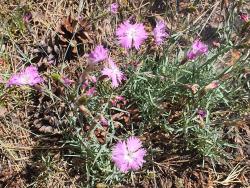 Goździk siny na nowym stanowisku na terenie Nadleśnictwa Poddębice RDLP w Łodzi.
Goździk siny na nowym stanowisku na terenie Nadleśnictwa Poddębice RDLP w Łodzi.
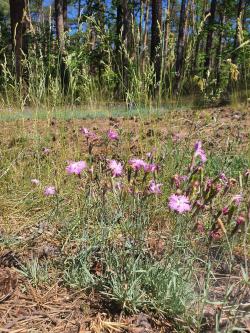 Goździk siny na nowym stanowisku na terenie Nadleśnictwa Poddębice RDLP w Łodzi.
Goździk siny na nowym stanowisku na terenie Nadleśnictwa Poddębice RDLP w Łodzi.
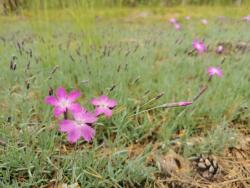 Goździk siny na nowym stanowisku na terenie Nadleśnictwa Poddębice RDLP w Łodzi.
Goździk siny na nowym stanowisku na terenie Nadleśnictwa Poddębice RDLP w Łodzi.
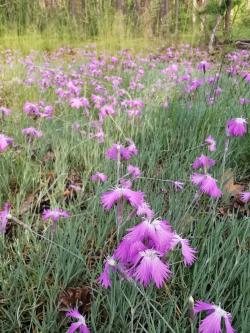 Goździk siny na nowym stanowisku na terenie Nadleśnictwa Poddębice RDLP w Łodzi.
Goździk siny na nowym stanowisku na terenie Nadleśnictwa Poddębice RDLP w Łodzi.
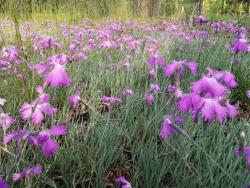 Goździk siny na nowym stanowisku na terenie Nadleśnictwa Poddębice RDLP w Łodzi.
Goździk siny na nowym stanowisku na terenie Nadleśnictwa Poddębice RDLP w Łodzi.
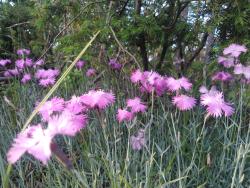 Goździk siny na nowym stanowisku na terenie Nadleśnictwa Poddębice RDLP w Łodzi.
Goździk siny na nowym stanowisku na terenie Nadleśnictwa Poddębice RDLP w Łodzi.
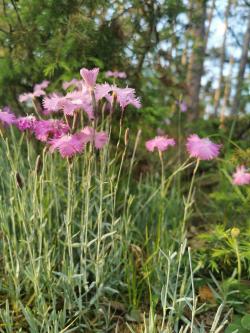 Goździk siny na nowym stanowisku na terenie Nadleśnictwa Poddębice RDLP w Łodzi.
Goździk siny na nowym stanowisku na terenie Nadleśnictwa Poddębice RDLP w Łodzi.
Leśnicy RDLP w Łodzi odnaleźli nowe, nieopisane dotychczas, stanowisko goździka sinego – gatunku zagrożonego wyginięciem.
Goździk siny Dianthus gratianopolitanus podlega ochronie ścisłej i wymaga ochrony czynnej. Wg Polskiej Czerwonej Księgi Roślin (2014) na terenie naszego kraju opisano 36 stanowisk tej rośliny. Większość z nich ma już jednak znaczenie tylko historyczne. Zostało prawdopodobnie jedynie 14. Goździk siny jest gatunkiem bardzo wrażliwym. Przegrywa konkurencję z innymi roślinami runa, ginie wskutek postępującej sukcesji, zacienienia przez warstwę podszyt i zwarcie drzewostanu, a wielokrotnie – w wyniku błędów lub nieświadomej działalności człowieka.
Na terenie RDLP w Łodzi jeszcze pod koniec XX wieku podawany był z 10 lokalizacji. Do dzisiaj, wg Czerwonej Księgi Roślin Województwa Łódzkiego, zachowało się już tylko 5. Dlatego nasze odkrycie jest tak ważne i stanowi istotny wkład do zasobów wiedzy botanicznej, nie tylko w skali regionalnej, ale i krajowej.
Stanowisko zostało odnalezione pod koniec maja, jednak z ujawnieniem informacji czekaliśmy na potwierdzenie oznaczenia gatunku przez eksperta. Po wspólnych oględzinach terenowych z botanikiem, dr hab. Marcinem Kiedrzyńskim z Wydziału Biologii i Ochrony Środowiska Uniwersytetu Łódzkiego, nie ma już żadnych wątpliwości – goździk znaleziony w Nadleśnictwie Poddębice to właśnie goździk siny Dianthus gratianopolitanus.
Znalezisko jest tym cenniejsze, że w lasach RDLP w Łodzi realizowany jest Regionalny program ochrony goździka sinego Dianthus gratianopolitanus VILL, opracowany przez botaników z Uniwersytetu Łódzkiego i Ogrodu Botanicznego w Łodzi. Uczestniczą w nim aktywnie łódzkie nadleśnictwa – te, w których jeszcze zachowały się populacje tego gatunku.
Więcej o Regionalnych programach ochrony wybranych gatunków roślin rzadkich i zagrożonych wyginięciem na terenie województwa łódzkiego można przeczytać tutaj (https://www.lodz.lasy.gov.pl/aktualnosci/-/asset_publisher/1M8a/content/ratowanie-ginacych-roslin).
Odnalezienie przez leśników nieznanego dotychczas stanowiska rzuca nowe światło i pozwala optymistyczniej patrzeć na perspektywy ochrony goździka sinego. Tym bardziej, że stanowisko to jest w tej chwili najmocniejszym w regionie łódzkim – tworzą go 4 płaty, liczące łącznie ponad 1000 pędów. Większość z nich to pędy generatywne (kwitnące i owocujące).
Populacja w Nadleśnictwie Poddębice (RDLP w Łodzi) weryfikuje też zasięg gatunku – znajduje się ponad 60 km na północ od dotychczasowych stwierdzeń goździka sinego w naszym regionie. Być może między tym stanowiskiem, a wykazywanymi w Czerwonej Księdze Roślin Województwa Łódzkiego, istnieją i trwają inne, niezidentyfikowane jeszcze kępy i płaty tej niezwykłej rośliny – Dianthus gratianopolitanus Vill.


 fot. Paweł Fabijański
fot. Paweł Fabijański
 fot. Paweł Fabijański
fot. Paweł Fabijański
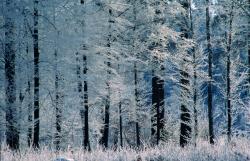 fot. Paweł Fabijański
fot. Paweł Fabijański
